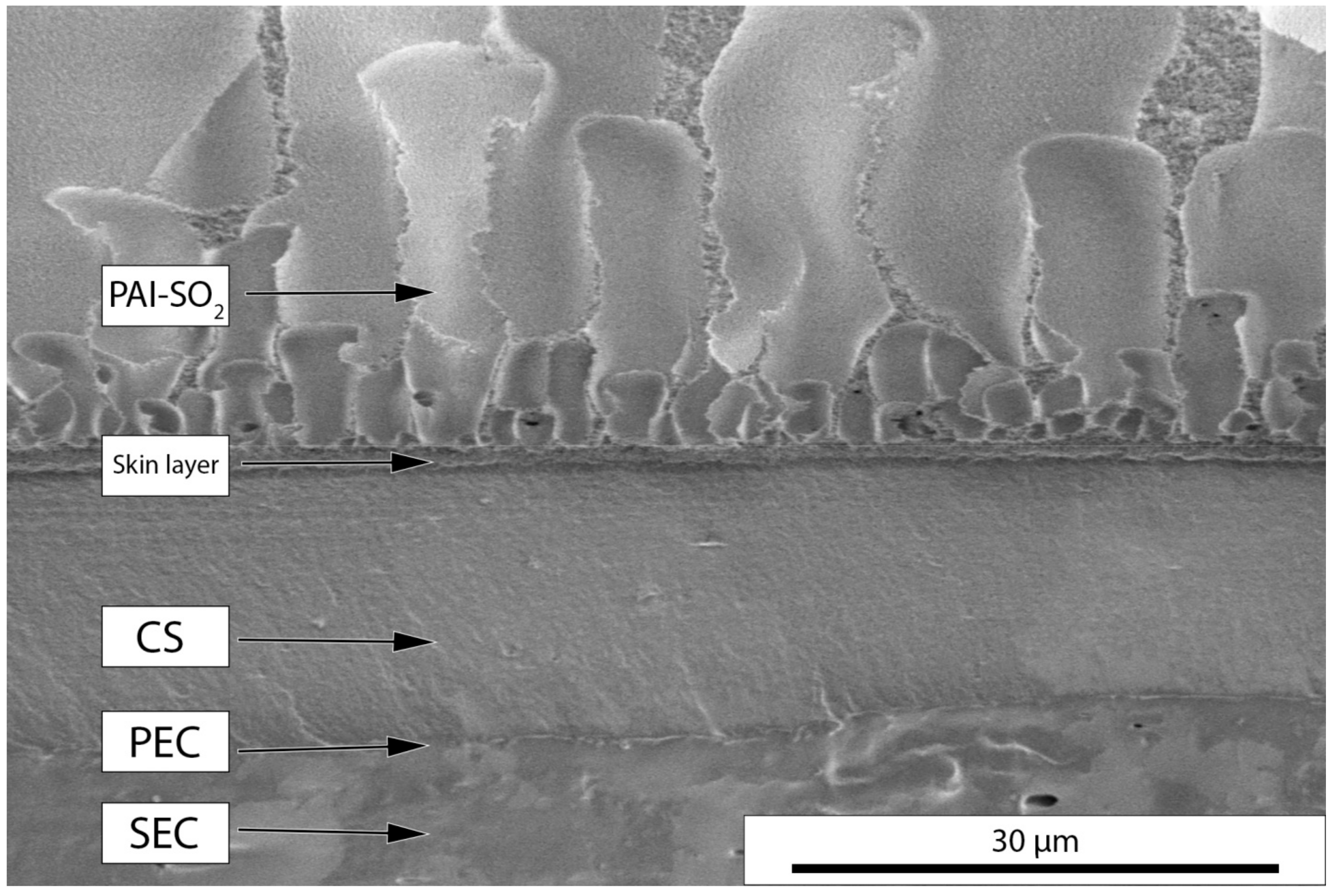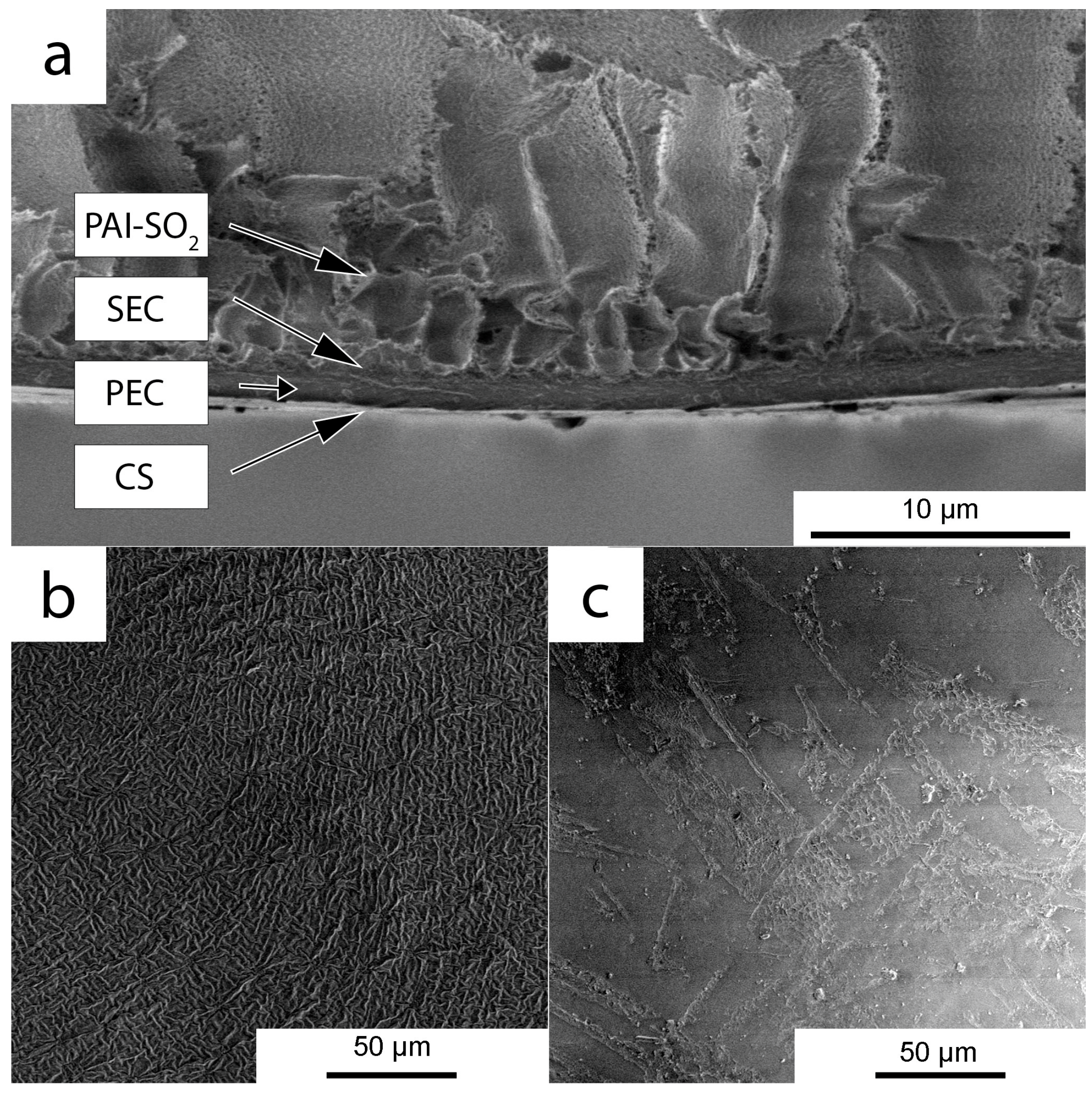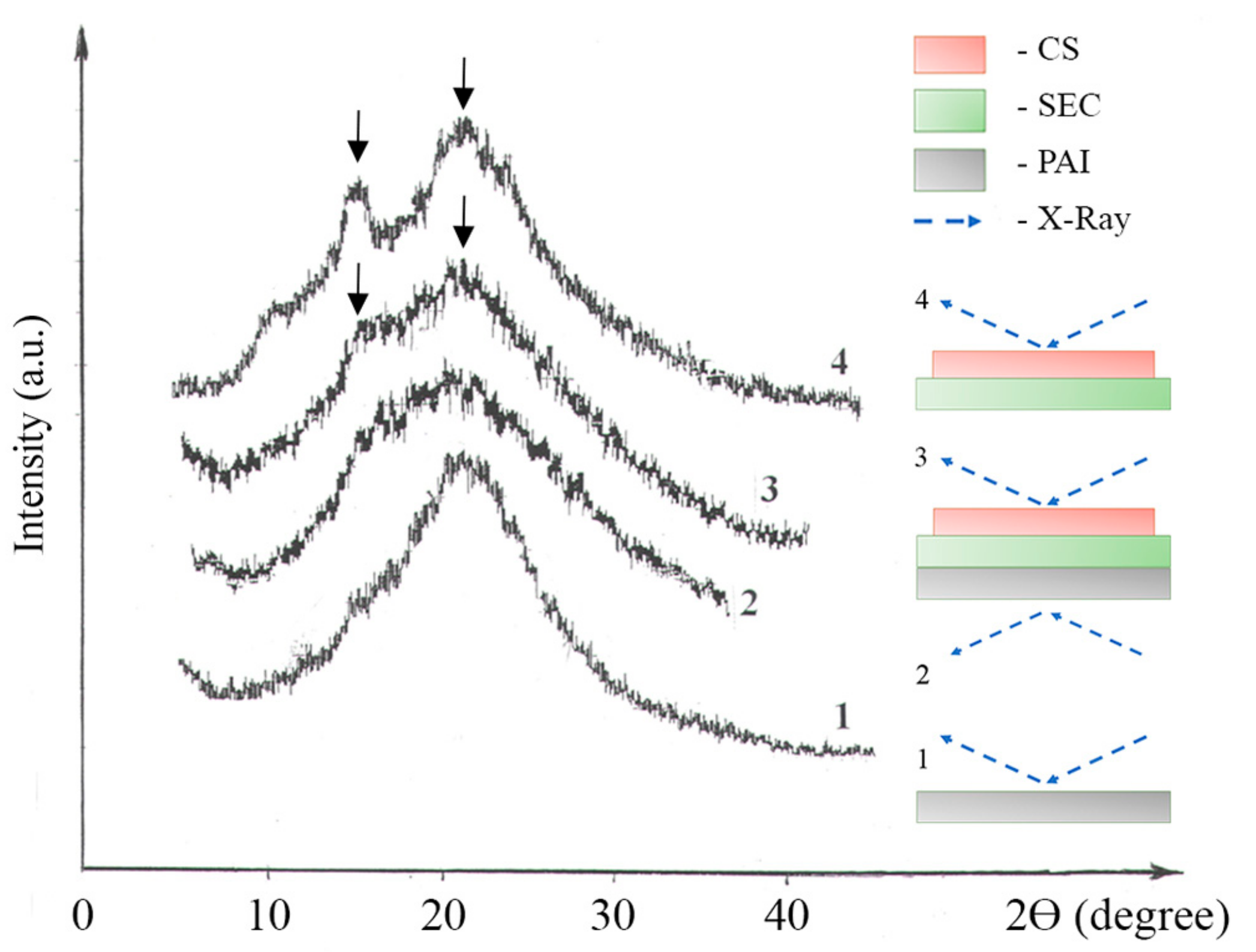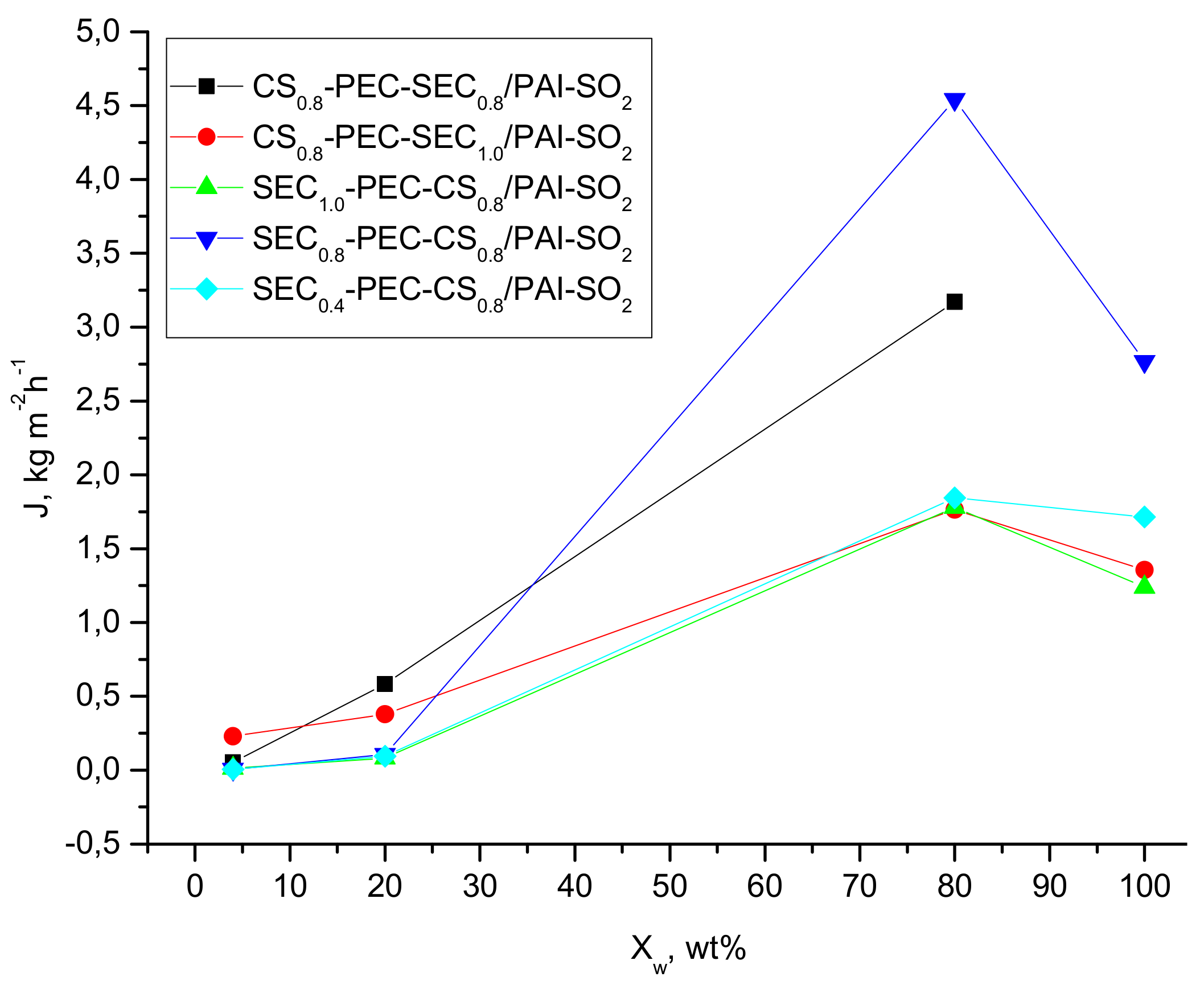Two-Ply Composite Membranes with Separation Layers from Chitosan and Sulfoethylcellulose on a Microporous Support Based on Poly(diphenylsulfone-N-phenylphthalimide)
Abstract
:1. Introduction
2. Results and Discussion
2.1. Preparation of CS-SEC Membranes on PAI-SO2 Support
2.2. Scanning Electron Microscopy Morphology Characterization
2.3. X-ray Diffraction
2.4. Pervaporation
3. Materials and Methods
3.1. Materials
3.2. Membrane Preparation
- -
- Coating 3 wt % aqueous solutions of SEC0.4, SEC0.8, or SEC1.0 onto the surface of the top layer (skin layer) of a microporous PAI-SO2 support and removing the excess solution after its minimal contact with the surface to obtain intermediate composites. After drying these composites (SEC0.4, SEC0.8, or SEC1.0/PAI-SO2) in air, the 3 wt % CS solution in aqueous acetic acid was cast onto the surface of the SEC layer, followed by removal the solvent in ambient conditions and then by vacuum degassing at 30 °C.
- -
- Coating the 3 wt % CS solution in aqueous acetic acid onto the surface of the skin layer of the PAI-SO2 substrate to obtain the intermediate composite CS0.8/PAI-SO2, followed by casting the SEC-layer onto the surface of the CS layer and drying as already described.
3.3. General Methods
3.4. Pervaporation Measurements
4. Conclusions
Acknowledgments
Author Contributions
Conflicts of Interest
References
- Zhao, Q.; An, Q.F.; Ji, Y.; Qian, J.; Gao, C. Polyelectrolyte complex membranes for pervaporation, nanofiltration and fuel cell applications. J. Membr. Sci. 2011, 379, 19–45. [Google Scholar] [CrossRef]
- Shieh, J.-J.; Huang, R.Y.M. Pervaporation with chitosan membranes II. Blend membranes of chitosan and polyacrylic acid and comparison of homogeneous and composite membrane based on polyelectrolyte complexes of chitosan and polyacrylic acid for the separation of ethanol-water mixtures. J. Membr. Sci. 1997, 127, 185–202. [Google Scholar] [CrossRef]
- Yao, K.D.; Peng, T.; Feng, H.B.; He, Y.Y. Swelling kinetics and release characteristic of crosslinked chitosan: Polyether polymer network (semi-IPN) hydrogels. J. Polym. Sci. Part A 1994, 32, 1213–1223. [Google Scholar] [CrossRef]
- Kim, S.-G.; Lee, K.-S.; Lee, K.-H. Pervaporation separation of sodium alginate/chitosan polyelectrolyte complex composite membranes for the separation of water/alcohol mixtures: Characterization of the permeation behavior with molecular modeling techniques. J. Appl. Polym. Sci. 2007, 103, 2634–2641. [Google Scholar] [CrossRef]
- Kuznetsov, Y.P.; Kruchinina, E.V.; Nud’ga, L.A.; Petrova, V.A.; Bochek, A.M.; Shishkina, G.V.; Matveeva, N.A. Dehydration of organic solvents by evaporation through membranes based on polyelectrolytic complexes. Russ. J. Appl. Chem. 2003, 76, 1807–1812. [Google Scholar] [CrossRef]
- Wang, X.-S.; Ji, Y.-L.; Zheng, P.-Y.; An, Q.-F.; Zhao, Q.; Lee, K.-R.; Qian, J.-W.; Gao, C.-J. Engineering novel polyelectrolyte complex membranes with improved mechanical properties and separation performance. J. Mater. Chem. A 2015, 3, 7296–7303. [Google Scholar] [CrossRef]
- Zhu, Z.; Feng, X.; Penlidis, A. Self-assembled nano-structured polyelectrolyte composite membranes for pervaporation. Mater. Sci. Eng. C 2006, 26, 1–8. [Google Scholar] [CrossRef]
- Van Ackern, F.; Krasemann, L.; Tieke, B. Ultrathin membranes for gas separation and pervaporation prepared upon electrostatic self-assembly of polyelectrolytes. Thin Solid Films 1998, 327, 762–766. [Google Scholar] [CrossRef]
- Huang, R.Y.M.; Pal, R.; Moon, G.Y. Pervaporation dehydration of aqueous ethanol and isopropanol mixtures through alginate/chitosan two ply composite membranes supported by poly(vinylidene fluoride) porous membrane. J. Membr. Sci. 2000, 167, 275–289. [Google Scholar] [CrossRef]
- Ma, L.; Yu, W.; Ma, X. Preparation and characterization of novel sodium alginate/chitosan two ply composite membranes. J. Appl. Polym. Sci. 2007, 106, 394–399. [Google Scholar] [CrossRef]
- Moon, Y.G.; Pal, R.; Huang, R.Y.M. Novel two-ply composite membranes of chitosan and sodium alginate for the pervaporation dehydration of isopropanol and ethanol. J. Membr. Sci. 1999, 156, 17–27. [Google Scholar] [CrossRef]
- Choudhari, S.K.; Premakshi, H.G.; Kariduraganavar, M.Y. Preparation and pervaporation performance of chitosan-poly(methacrylic acid) polyelectrolyte complex membranes for dehydration of 1,4-dioxane. Polym. Eng. Sci. 2016, 56, 715–724. [Google Scholar] [CrossRef]
- Zhao, Q.; Qian, J.; An, Q.; Gao, C.; Gui, Z.; Jin, H. Synthesis and characterization of soluble chitosan/sodium carboxymethyl cellulose polyelectrolyte complexes and the pervaporation dehydration of their homogeneous membranes. J. Membr. Sci. 2009, 333, 68–78. [Google Scholar] [CrossRef]
- Ageev, E.P.; Vikhoreva, G.A.; Gal’braikh, L.S.; Matushkina, N.N.; Chaika, E.M.; Jaminsky, I.V. Preparation and properties of films based on chitosan and polyelectrolyte complexes of chitosan with carboxymethylchitin. Polym. Sci. Ser. A 1998, 40, 757–762. [Google Scholar]
- Lee, Y.M.; Shin, E.M.; Noh, S.T. Pervaporation separation of water-ethanol through modified chitosan membranes, II. Carboxymethyl, carboxyethyl, cyanoethyl, and amidoxime chitosan membranes. Angew. Makromol. Chem. 1991, 192, 169–181. [Google Scholar] [CrossRef]
- Kononova, S.V.; Volod’ko, A.V.; Petrova, V.A.; Kruchinina, E.V.; Baklagina, Y.G.; Chusovitin, E.A.; Skorik, Y.A. Pervaporation multilayer membranes based on a polyelectrolyte complex of λ-carrageenan and chitosan. Carbohydr. Polym. 2018, 181, 86–92. [Google Scholar] [CrossRef]
- Barck, K.; Butler, M.F. Comparison of morphology and properties of polyelectrolyte complex particles formed from chitosan and polyanionic biopolymers. J. Appl. Polym. Sci. 2005, 98, 1581–1593. [Google Scholar] [CrossRef]
- Baklagina, Y.G.; Kononova, S.V.; Petrova, V.A.; Kruchinina, E.V.; Nud’Ga, L.A.; Romanov, D.P.; Klechkovskaya, V.V.; Orekhov, A.S.; Bogomazov, A.V.; Arkhipov, S.N. Study of polyelectrolyte complexes of chitosan and sulfoethyl cellulose. Crystallogr. Rep. 2013, 58, 287–294. [Google Scholar] [CrossRef]
- Petrova, V.A.; Orekhov, A.S.; Chernyakov, D.D.; Baklagina, Y.G.; Romanov, D.P.; Kononova, S.V.; Volod’ko, A.V.; Ermak, I.M.; Klechkovskaya, V.V.; Skorik, Y.A. Preparation and analysis of multilayer composites based on polyelectrolyte complexes. Crystallogr. Rep. 2016, 61, 945–953. [Google Scholar] [CrossRef]
- Dautzenberg, H.; Klohr, E.-A.; Knop, S.; Koch, W.; Kulicke, W.-M.; Schwarz, H.-H.; Thielking, H. Symplex Membrane. Patent EP1115475 A1, 18 July 2001. [Google Scholar]
- Clasen, C.; Wilhelms, T.; Kulicke, W.M. Formation and characterization of chitosan membranes. Biomacromolecules 2006, 7, 3210–3222. [Google Scholar] [CrossRef] [PubMed]
- Thielking, H.; Klohr, E.-A.; Koch, W.; Dautzenberg, H.; Schwarz, H.-H.; Knop, S.; Kulicke, W.-M. Simplex Membrane, for Separation of Water from Organic Materials, Contains at Least One Sulfoalkyl Group Containing Cellulose Ether Polyanion as Anionic Component. Patent DE19837673A1, 24 February 2000. [Google Scholar]
- Manshad, S.; Nawawi, M.G.M.; Sazegar, M.R.; Hassan, H.B.; Alamaria, A.M. Membranes with favorable chemical materials for pervaporation process: A review. J. Membr. Sci. Technol. 2016, 6, 164. [Google Scholar] [CrossRef]
- Baker, R.W. Membrane Technology and Applications, 2nd ed.; John Wiley & Sons Ltd.: Chichester, UK, 2004. [Google Scholar]
- Kononova, S.V.; Gubanova, G.N.; Romashkova, K.A.; Korytkova, E.N.; Timpu, D. Polyamide-imide membranes of various morphology—Features of nano-scale elements of structure. In Scanning Probe Microscopy-Physical Property Characterization at Nanoscale; Nalladega, V., Ed.; InTech: Rijeka, Croatia, 2012; pp. 81–102. [Google Scholar]
- Kononova, S.V.; Kuznetsov, Y.P.; Apostel, R.; Paul, D.; Schwarz, H.-H. New polymer multilayer pervaporation membrane. Angew. Makromol. Chem.. 1996, 237, 45–53. [Google Scholar] [CrossRef]
- Kuznetsov, Y.P.; Kononova, S.V.; Kruchinina, E.V.; Romashkova, K.A.; Svetlichnyi, V.M.; Molotkov, V.A. Pervaporation membranes for separating mixtures of methanol and methyl tert-butyl ether. Russ. J. Appl. Chem. 2001, 74, 1338–1342. [Google Scholar] [CrossRef]
- Kononova, S.V.; Kremnev, R.V.; Suvorova, E.I.; Baklagina, Y.G.; Volchek, B.Z.; Uchytil, P.; Shabsels, B.M.; Romashkova, K.A.; Setnickova, K.; Reznickova, J. Pervaporation membranes with poly(γ-benzyl-l-glutamate) selective layers for separation of toluene–n-heptane mixtures. J. Membr. Sci. 2015, 477, 14–24. [Google Scholar] [CrossRef]
- Kononova, S.V.; Romashkova, K.A.; Gofman, I.V.; Kremnev, R.V.; Kruchinina, E.V.; Svetlichnyi, V.M. Aromatic polysulfone imides and membranes based on them. Russ. J. Appl. Chem. 2009, 82, 1033–1040. [Google Scholar] [CrossRef]
- Krajewska, B. Membrane-based processes performed with use of chitin/chitosan materials. Sep. Purif. Technol. 2005, 41, 305–312. [Google Scholar] [CrossRef]
- Orekhov, A.S.; Klechkovskaya, V.V.; Kononova, S.V. Low-voltage scanning electron microscopy of multilayer polymer systems. Crystallogr. Rep. 2017, 62, 710–715. [Google Scholar] [CrossRef]
- Plisko, E.A.; Nud’ga, L.A. Determination of molecular weight of sulfoethyl ether of cellulose by osmometry. Vysokomol. Soedin. Ser. B 1967, 9, 825–827. [Google Scholar]
- Gusinskaya, V.A.; Koton, M.M.; Batrakova, T.V.; Romashkova, K.A. Poly(amide-imide)s based on symmetric and asymmetric dichloride-imide acids. Vysokomol. Soedin. Ser. A 1976, 18, 2681–2686. [Google Scholar]
- Pogodina, N.V.; Pavlov, G.M.; Bushin, S.V.; Mel’nikov, A.B.; Lysenko, Y.B.; Nud’ga, L.A.; Marsheva, V.N.; Marchenko, G.N.; Tsvetkov, V.N. Conformational characteristics of chitosan molecules as demonstrated by diffusion-sedimentation analysis and viscometry. Polym. Sci. U.S.S.R. 1986, 28, 251–259. [Google Scholar] [CrossRef]
Sample Availability: Samples of the compounds ...... are available from the authors. |





| Entry # | Film Type | Concentration in Feed (X) (wt %) | Concentration in Permeate (Y) (wt %) | T (°C) | SFw | J (kg·m−2·h−1) | ||||
|---|---|---|---|---|---|---|---|---|---|---|
| Propan-2-ol | Ethanol | Water | Propan-2-ol | Ethanol | Water | |||||
| 1-1 | SEC0.8-PEC-CS0.8/PAI-SO2 | 20 | - | 80 | 20 | - | 80 | 40 | 1 | 3.9 |
| 1-2 | 80 | - | 20 | 1 | - | 99 | 40 | 308 | 0.9 | |
| 1-3 | >85 | - | <15 | 0 | - | 100 | 40 | >550,000 | <0.3 | |
| 1-4 | 100 | - | - | 100 | - | - | 40 | - | 0.01 | |
| 1-5 | - | 20 | 80 | - | 21 | 79 | 40 | 1 | 4.5 | |
| 1-6 | - | 80 | 20 | - | 35 | 65 | 40 | 7 | 0.1 | |
| 2-1 | CS0.8-PEC-SEC0.8/PAI-SO2 | - | 18 | 82 | - | 17 | 83 | 40 | 1 | 2.5 |
| 2-2 | - | 96 | 4 | - | 83 | 17 | 40 | 5 | 0.05 | |
| 3-1 | SEC0.4-PEC-CS0.8/PAI-SO2 | - | 20 | 80 | - | 18 | 82 | 40 | 1.2 | 1.84 |
| 3-2 | - | 96 | 4 | - | 18 | 82 | 51 | 108 | 0.008 | |
| 4-1 | CS0.8-PEC-SEC0.4/PAI-SO2 | 20 | - | 80 | 19 | - | 81 | 40 | 1 | 3.9 |
| 4-2 | 80 | - | 20 | 3 | - | 97 | 40 | 127 | 0.8 | |
| 4-3 | 100 | - | - | 100 | - | - | 40 | - | 0.01 | |
| 5-1 | SEC1.0-PEC-CS0.8/PAI-SO2 | - | 30 | 70 | - | 26 | 74 | 40 | 1.2 | 7.41 |
| 5-2 | - | 80 | 20 | - | 2 | 98 | 40 | 181 | 0.08 | |
| 5-3 | - | 96 | 4 | - | 14 | 86 | 51 | 150 | 0.003 | |
| 6-1 | CS0.8-PEC-SEC1.0/PAI-SO2 | 80 | - | 20 | 2 | - | 98 | 40 | 188 | 0.7 |
| 6-2 | 100 | - | - | 100 | - | - | 40 | - | 0.007 | |
| 6-3 | - | 20 | 80 | - | 12 | 88 | 40 | 1.8 | 1.82 | |
| 6-4 | - | 80 | 20 | - | 2 | 98 | 40 | 190 | 0.16 | |
| 6-5 | - | 96 | 4 | - | 65 | 35 | 40 | 13 | 0.23 | |
© 2017 by the authors. Licensee MDPI, Basel, Switzerland. This article is an open access article distributed under the terms and conditions of the Creative Commons Attribution (CC BY) license (http://creativecommons.org/licenses/by/4.0/).
Share and Cite
Kononova, S.V.; Kruchinina, E.V.; Petrova, V.A.; Baklagina, Y.G.; Romashkova, K.A.; Orekhov, A.S.; Klechkovskaya, V.V.; Skorik, Y.A. Two-Ply Composite Membranes with Separation Layers from Chitosan and Sulfoethylcellulose on a Microporous Support Based on Poly(diphenylsulfone-N-phenylphthalimide). Molecules 2017, 22, 2227. https://doi.org/10.3390/molecules22122227
Kononova SV, Kruchinina EV, Petrova VA, Baklagina YG, Romashkova KA, Orekhov AS, Klechkovskaya VV, Skorik YA. Two-Ply Composite Membranes with Separation Layers from Chitosan and Sulfoethylcellulose on a Microporous Support Based on Poly(diphenylsulfone-N-phenylphthalimide). Molecules. 2017; 22(12):2227. https://doi.org/10.3390/molecules22122227
Chicago/Turabian StyleKononova, Svetlana V., Elena V. Kruchinina, Valentina A. Petrova, Yulia G. Baklagina, Kira A. Romashkova, Anton S. Orekhov, Vera V. Klechkovskaya, and Yury A. Skorik. 2017. "Two-Ply Composite Membranes with Separation Layers from Chitosan and Sulfoethylcellulose on a Microporous Support Based on Poly(diphenylsulfone-N-phenylphthalimide)" Molecules 22, no. 12: 2227. https://doi.org/10.3390/molecules22122227






